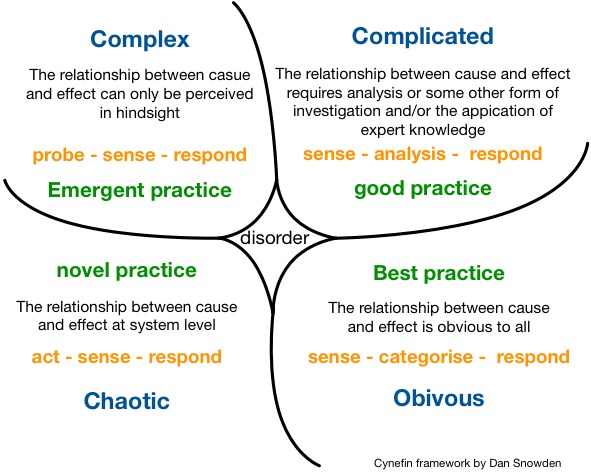
Making Sense of Chaos: How the Cynefin Framework Helps Companies Navigate Complexity
Share
Making Sense of Chaos: How the Cynefin Framework Helps Companies Navigate Complexity
In today’s fast-moving, ever-shifting business landscape, leaders are constantly trying to figure out one key thing:
"What the hell is going on — and what should we do about it?"
That’s where the Cynefin Framework comes in. (Pronounced “ku-nev-in” — Welsh is wild, we know.).
Developed by Dave Snowden at IBM in the early 2000s, Cynefin is more than just a decision-making tool — it's a sense-making model. It helps teams and leaders understand the nature of the situations they’re facing… so they can respond appropriately.
Let’s break it down — and see how companies can use it to stop guessing and start acting smarter.
What is the Cynefin Framework?
Cynefin categorizes situations into five domains:
1. Obvious (formerly “Simple”)
-
Cause and effect are crystal clear.
-
Best practices exist.
-
Example: Processing payroll, sending invoices.
Approach: Sense – Categorize – Respond
Just do what’s known to work. Follow the recipe.
2. Complicated
-
Cause and effect exist, but need analysis or expert knowledge.
-
Multiple “right” answers possible.
-
Example: Diagnosing a car problem, building custom software.
Approach: Sense – Analyze – Respond
Bring in the experts. Don’t guess.
3. Complex
-
Cause and effect are only clear in retrospect.
-
Patterns emerge over time — lots of unknowns.
-
Example: Organizational culture change, launching a product in a new market.
Approach: Probe – Sense – Respond
Run safe-to-fail experiments. Learn by doing.
4. Chaotic
-
No clear relationship between cause and effect.
-
Immediate action needed to stabilize the situation.
-
Example: PR crisis, cyberattack, natural disaster response.
Approach: Act – Sense – Respond
Triage the chaos. Regain control first.
5. Disorder
-
You don’t know which domain you’re in yet.
-
People fall back on what they’re comfortable with — often the wrong response.
The goal is to break down the situation into parts you can classify.

So… How Does This Apply to Companies?
Companies face all five domains — sometimes in the same day.
Here’s how the Cynefin framework helps:
Avoids one-size-fits-all solutions
Many companies try to apply “best practices” to everything. But what works in Obvious domains fails miserably in Complex or Chaotic ones. Cynefin teaches you to match your actions to the context.
Encourages experimentation
In Complex environments, trying to plan everything in detail is a waste of time. Cynefin gives teams permission to experiment, fail safely, and learn fast.
Improves communication
Leaders, managers, and teams often speak past each other. Cynefin gives everyone a shared language to talk about complexity — no more “just make a plan” when you’re in the messy middle of change.
Crisis navigation
In Chaotic situations (hello, 2020), Cynefin says: act fast, make sense of what’s happening, then stabilize. It helps prevent panic — or worse, pretending things are under control when they aren’t.
Cynefin in Practice: Some Real-World Examples
-
Agile Teams: Use it to decide when to follow a defined process (Complicated) vs. when to explore (Complex).
-
Executives: Use it to frame strategic discussions — not everything is a spreadsheet problem.
-
HR & Culture Teams: Use it to guide transformation — culture is not a checklist.
Final Thoughts
Cynefin isn’t a silver bullet — but it is a superpower. It helps teams and leaders:
-
Understand what kind of problem they’re facing
-
Respond with the right mindset and tools
-
Get comfortable with not always having the answer right away
In a world obsessed with control, Cynefin reminds us: sometimes you need to explore the unknown before you can shape it.
So next time your team is stuck, ask:
Are we in the Obvious? Complicated? Complex? Chaotic? Or just plain confused?
And then decide how to act — not just what to do.
Want Help Navigating Complexity?
At Growing Centuries, we don’t just talk about frameworks — we use them to spark real change.
Whether you're dealing with:
-
A messy digital transformation,
-
Misaligned teams,
-
Leadership struggles,
-
Or just too many unknowns…
We bring tools like Cynefin, Agile, team coaching, and deep facilitation to help you make sense of the chaos and move forward with confidence.
Because real growth takes time — and the right support.
👣 Let’s walk that path together.
Supplementary reading
👉 Explore our services or contact us to start the conversation.
By: Ricardo Fernandes
